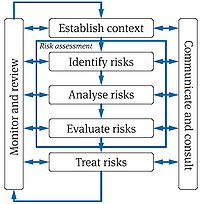Risk management process
Bjarnijakob (Talk | contribs) |
Bjarnijakob (Talk | contribs) |
||
| Line 40: | Line 40: | ||
==== Establish the context ==== | ==== Establish the context ==== | ||
| + | |||
| + | The first step in the RMP is establish the context and is key to effective and great risk management. The context will act like a supervisor to ensure that all activities will remain relevant throughout the process. There are various context that needs to be taken into account and to articulate the objective of the project or organization. Establishing the context can be found with SWOT analysis, by identify strengths, weakness, opportunities and threats. The SWOT analysis can identify the PESTEL, which is the political, economic, social and technological, environmental and legal condition of the context. Context can be divided in external and internal context. Furthermore, the context will set the scope for the risk criteria for later processes and should be establish each time it is implemented | ||
[[File:SWOTen.svg|thumb|SWOT en]] | [[File:SWOTen.svg|thumb|SWOT en]] | ||
Revision as of 08:24, 13 September 2016
Risk management process (RMP) is a concept or a framework to managing risk both internal and external in all industries. It is a concept that has been coming popular for project managers in projects to improve performance and increase the profit. This concept helps management teams to construct a strong and systematic approach to the risk identification. With risk process and strong project management practice the problems in a project can by decreased and could also help to resolve problems that occur later on in projects.
Risk vary in projects because of the uniqueness of every project and due to that fact the concept RMP is very robust approach. Identification, understanding and managing critical risk that can harm the project a concept needs to be followed.
Risk management in project should be throughout the project life cycle. In some cases the risk management is primarily done in the design phase of the project, but should be also manage in the construction phase. The RMP is a five step process that is following [1].
- Step 1 – Establish the context
- Step 2 – Identify the risk
- Step 3 – Analyse the risk
- Step 4 – Evaluate the risk
- Step 5 – Treat the risk
The risk management process is essential to manage those risk that can occur in projects and to be able to mitigate those risks. This wiki article aims to go through those steps mention above with few techniques and methods that are well known in risk management and how to apply them along the project life cycle. Furthermore, the background of risk management, advantages and RMP limitation will also be discussed.
Contents |
Overview
Introduction
[2].
Application of risk management process
The RMP is not a standalone concept that can be implemented into project or organization. To be able to managing risk effectively through the RMP a well define risk management framework has to be clear. The framework will provide the foundation for success risk management. The RMP at each step will communicate with the risk management framework, as can be seen in Figure 1, and therefore establish a holistic approach to risk management.

RMP can be seen in Figure 2, the five steps in the RMP are well defined and easy to follow with good management practice. In this section the five RMP steps will be explain further and how it can be applied to managing risk. In those five steps that is within the RMP is the risk assessment. Risk assessment is an overgroup of 3 steps, identify risk, analyse risk and evaluate risk. Inside these subgroups of risk assessment are few methodologies that are used to help the management team to establish the right outcome of the RMP. These methodologies will be mention briefly to explain what is used in practice today.
Even though the communication, consult, monitoring and review is not part of the five steps, it is key element of risk management. It is essential to communicate and consult with stakeholders, from early stage, in the value chain during all five steps of the RMP. Stakeholders have to understand the basis in decisions and why action is needed for specific risk. This is done by effective communication both internally and externally with stakeholders within and outside the organization.

Establish the context
The first step in the RMP is establish the context and is key to effective and great risk management. The context will act like a supervisor to ensure that all activities will remain relevant throughout the process. There are various context that needs to be taken into account and to articulate the objective of the project or organization. Establishing the context can be found with SWOT analysis, by identify strengths, weakness, opportunities and threats. The SWOT analysis can identify the PESTEL, which is the political, economic, social and technological, environmental and legal condition of the context. Context can be divided in external and internal context. Furthermore, the context will set the scope for the risk criteria for later processes and should be establish each time it is implemented
Risk identification
How to identify risks
WIP
Risk analysis
Methods for risk analysis
WIP
Risk evaluation
WIP
Risk treatment/response
WIP
Monitoring risk
WIP
Advantages
WIP
Limitations
WIP
References
- ↑ 1.0 1.1 1.2 John Lark.(2015) ISO 31000, Risk management.
- ↑ Neil, G.C.(1982) The Bibliography and History of Risk Management: Some Preliminary Observations, 7(23),169-179.
- ↑ Smith. N.J., Merna, T. and Jobbling p.,(2006) Managing Risk in Construction Projects.
- ↑ Kozin. I.,(2015) Course 42172: Risk and decision making.
- ↑ Gajewska. E. and Ropel. M.,(2011) Risk Management Practices in a Construction Project – a case study.